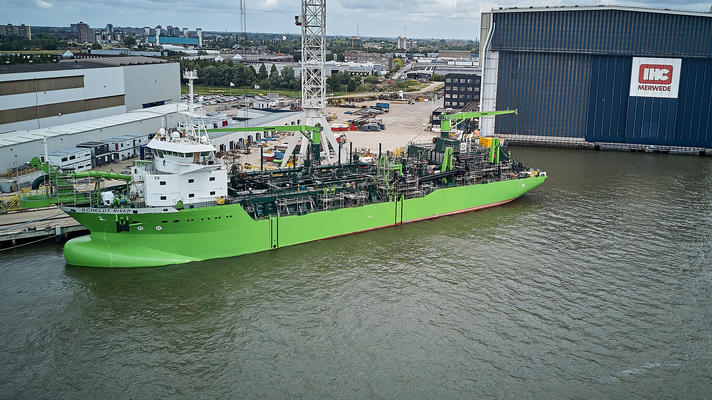Last night (12 November), Royal IHC was awarded the Maritime Award KNVTS Ship of the Year 2018 for the Scheldt River.
The trailing suction hopper dredger (TSHD) Scheldt River was designed and built by Royal IHC and delivered to the Belgian marine contractor DEME on 25 September 2017. The jury was impressed with the steps taken to make dredging more sustainable, the most notable off which, is the choice for LNG.
First TSHDs on LNG
The Scheldt River and the smaller Minerva, also built by Royal IHC for DEME at the same time, are the first dual-fuel TSHDs in the world that can operate on LNG. With these vessels, DEME has made a clear choice for LNG as the primary low emission fuel in order to meet the strictest regulations in the field of exhaust emissions in the coming years.
Handling High Variations in Engine Load
A disadvantage of LNG as a fuel for powering dredgers, is that dual-fuel engines running on LNG cannot really handle the high variations in engine load resulting from the dredging process. This problem was tackled on the Scheldt River in a very clever way by two innovations: a hybrid pump drive in combination with improved Wärtsilä engine management. This implies:
- The sand pump is driven in a hybrid way, diesel-direct and diesel-electric simultaneously, by both main engines. In this way, load variations are divided over the two engines, thereby keeping within the dual-fuel engine’s critical limits.
- Dual-fuel engines supplier Wärtsilä has succeeded in making their innovative LNG engine management more suitable for dredge power variations.
- In addition, in extreme cases, the engines can quickly be switched to MDO operation.
Switchable Gearbox
Additionally, the two variable pitch propellers are driven via a two speed IHC patented switchable gearbox, which ensures that both engines and propellers operate at optimum load.
High Degree of Automation
The Scheldt River is equipped with a further improved IHC one-man bridge, in which both sailing and dredging functions are combined. This implies a high degree of automation:
- The improved IHC DP-DT System ensures very precise positioning and track keeping.
- For the automation of the dredging process, the recently developed IHC ECO automation is applied, consisting of “Trailspeed Control”, “Automatic Visor Control” and “Eco Pump Control”. These work together under an artificial intelligence umbrella. This results into high dredged productions with as little overflow losses as possible and, thus, as little pollutive turbidity of the surface water as possible.
Further Efficiency
Among others, further efficiency is achieved by:
CFD twin-gondola stern, including a stern thruster, that has been optimised further;
Wing-shaped innovative bow thruster openings;
Extension of the time between dry-docking periods from 5 to 7.5 years, together with an in-water survey notation; and
Innovative bottom door seals that can be exchanged in the water.
Other Nominees
In total, three ships were nominated for the award. The other two nominees were:
- Reversed Sterndrive Drive (RSD) Tug 2513 Twin Fin "Innovation"; designed and partially built by Damen Shipyards Gorinchem at Gorinchem, the Netherlands.
- Patrol vessel "RPA 8"; designed and built by Shipyard Gebr. Kooiman BV at Zwijndrecht, the Netherlands.
Maritime Awards Gala
The Maritime Award KNVTS Ship of the Year 2018 was presented to the winner at the Maritime Awards Gala which took place last night at Taets Art and Event Park in Zaandam, the Netherlands. The Ship of the Year was one of five awards presented there. The other four were the Maritime Innovation Award, the Maritime Designer Award, the Maritime RNLN Van Hengel-Spengler Award and the Maritime KVNR Shipping Award.
Picture by Royal IHC.








